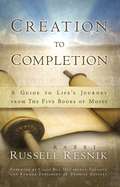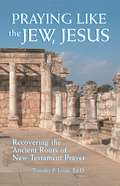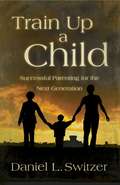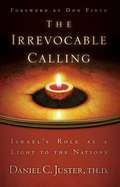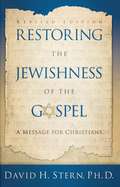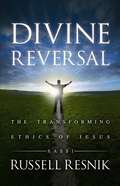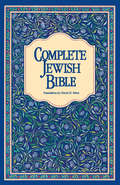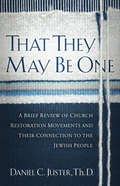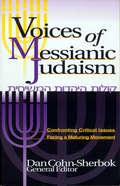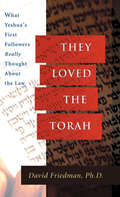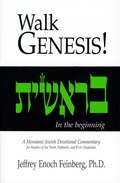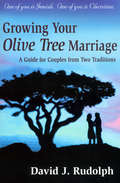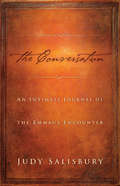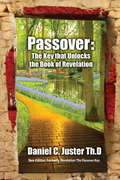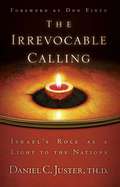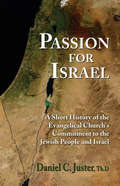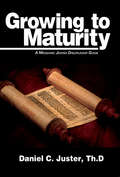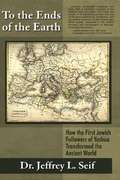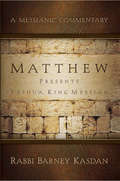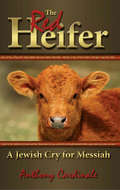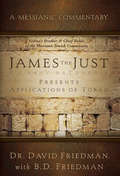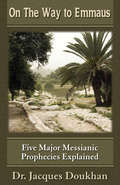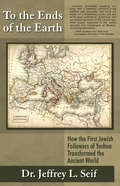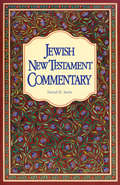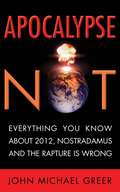- Table View
- List View
Creation to Completion: A Guide to Life’s Journey from The Five Books of Moses
by Rabbi Russell ResnikA commentary on each of the weekly portions read in traditional synagogues, a practice seen in the New Testament.
Praying Like the Jew, Jesus: Recovering the Ancient Roots of New Testament Prayer
by Ed. D. Timothy P. JonesBrings to life the prayers found in the New Testament and explains their relationship to Jewish prayer of that era.
Train Up a Child: Successful Parenting for the Next Generation
by Ed. D. Daniel L. SwitzerDraws on biblical and traditional Jewish sources to give fresh insight into how parents can disciple their children in the ways of the Lord.
The Irrevocable Calling: Israel's Role as a Light to the Nations
by Daniel C. Juster Th. D.Shows how the Jewish people are still the chosen people and continue to be called to bring blessing to the world today.
Restoring The Jewishness of the Gospel: A Message for Christians Condensed from Messianic Judaism
by David H. SternIntroduces Christians to Messianic Judaism. Explains how both Jews and Christians are God's people, the difference between Jews and Gentiles in the Church, how God relates to Jews today and the relevance of the Lw of Moses for today.
Divine Reversal: The Transforming Ethics of Jesus
by Rabbi Russell ResnikIn the Old Testament, God often reversed the plans of man. Yeshua's ethics continue this theme. Following his ethics leads to true happiness, forgiveness, reconciliation, fidelity and love.
Complete Jewish Bible: An English Version of the Tanakh (Old Testament) and B’rit Hadashah (New Testament)
by David H. SternThe only English translation that expresses the Bible's original and essential Jewishness from Genesis to Revelation. It reconnects Christians to their Jeiwsh roots and Jews to their Messiah.
That They May Be One: A Brief Review of Church Restoration Movements and Their Connection to the Jewish People
by Daniel C. JusterDan Juster describes how the various restoration movements in church history have connected to their Jewish roots an Israel to lay the groundwork for what is happening today.
Voices of Messianic Judaism: Confronting Critical Issues Facing a Maturing Movement
by David J. RudolphVoices Of Messianic Judaism is not just a book of opinions, it is a collection of substantive articles compiled to focus discussion on some weighty matters facing the Messianic Jewish movement.
They Loved the Torah: What Yeshua's First Followers Really Thought About the Law
by David FriedmanEven though many Jews believe that Paul taught against the Law, this book disproves that notion. Most Christians are disconnected from the Torah; reading this book will reconnect them. Dr. Friedman Makes an excellent case.
Walking Genesis: In The Beginning. A Messianic Jewish Devotional Commentary. For Readers of the Torah, Haftarah, and B'rit Chaadashah (Walk Ser. #1)
by Jeffrey Enoch FeinbergThis commentary follows the weekly Torah readings from the synagogue, along with the related Haftarah readings. Helps you relate the ancient Scripture to your daily walk.
Growing your Olive Tree Marriage: One of you if Jewish. One of you is Christian. A Guide for Couples From Two Traditions
by David J. RudolphDo you celebrate Hanukkah, Christmas, or both? Do you worship in a church, a synagogue, or no place at all? How will you raise your children - Jewish or Christian? Growing Your Olive Tree Marriage addresses these issues and more for intermarrieds.
The Conversation: An Intimate Journal of The Emmaus Encounter
by Judy SalisburyThe Conversation brings to life that famous encounter between the two disciples and Yeshua on the road to Emmaus.
Passover The Key that Unlocks the Book of Revelation: The Key That Unlocks The Book Of Revelation
by Daniel C. JusterDan Juster offers some fascinating insights into the Passover/Exodus story that make the symbolism in the Book of Revelation more understandable.
The Irrevocable Calling: Israel's Role as a Light to the Nations
by Daniel C. Juster Th. D.Shows how the Jewish people are still the chosen people and continue to be called to bring blessing to the world today.
Passion for Israel: A Short History of the Evangelical Church's Commitment to the Jewish People and Israel
by Daniel C. JusterThis book is written to counter a new sort of anti-Semitism Replacement Theology - and to address other destructive widespread distortions.
Growing to Maturity: A Messianic Jewish Discipleship Guide
by Daniel C. JusterThis discipleship guide presents first steps of understanding and spiritual practice, tailored for the Jewish believer, but applicable to anyone.
To the Ends of the Earth: How the First Jewish Followers of Yeshua Transformed the Ancient World
by Jeffrey L. Seif"What became of the first Jewish followers of Yeshua (Jesus)? This book examines the origin of the Yeshua movement and sets the record straight about how the appeal of Judaism and the message of the Messiah combined to transform the ancient pagan world. Readers may be surprised and intrigued to discover that Torah-observant Jewish believers in Yeshua and Gentile believers were actually more in concert than in conflict. There is another story than the one commonly heard about what we call Christian beginnings. The notion that the early Jewish followers of Yeshua disdained Judaism and went on to start a new religion, happily divested themselves of their Jewish heritage as soon as possible, needs to be reassessed. This book offers an in-depth exploration of the impact of these unified communities of Jewish and Gentile believers throughout the Mediterranean region in the periods now labeled as the Apostolic, sub-Apostolic, and post-Apostolic eras." The author's substantiates his facts and reflections from the writings of modern and ancient scholars. The author, Jeffrey Seif, Ph.D., . . . "is best known through his work at the teaching helm of the nationally-syndicated television program, "Zola Levitt Presents. He has also served as a professor of Jewish Studies at a number of academic institutions. Jeff studied at the Moody Bible Institute in Chicago, and subsequently took a master's degree and doctorate from Southern Methodist University, Dallas, in theology and ministry."
Matthew: Presents Yeshua, King Messiah
by Rabbi Barney KasdanIf you ever wanted to get to know Yeshua, the Jewish Messiah, the Good News of Matthew is the best place to start. Get to know Yeshua, the King, throught the writing of another rabbi, Barney Kasdan.
The Red Heifer: A Jewish Cry for Messiah
by Anthony CardinaleLife interviews are interwoven within an engaging and dramatic fictional portrayal of the diverse people of Israel and how they would react should that red heifer be found.
James - The Just Presents Applications of Torah: A Messianic Commentary
by Dr David FriedmanWhen we view Ya'acov (James) for who he was: a chief rabbi, a Torah scholar, a Bible commentator, and akin to a high court judge, then we can better understand the purpose of his book.
On The Way To Emmaus: Five Major Messianic Prophecies Explained
by Jacques DoukhanThe discussion about messianic prophecies is therefore an important one. It hits at the very origins of Christianity and takes us to the very heart of the early Jewish-Christian controversy
To The Ends Of The Earth: How the First Jewish Followers of Yeshua Transformed the Ancient World
by Dr Jeffrey L. SeifYou do know that the first followers of Yeshua (Jesus) were Jews. And everyone knows by now that Jews spread his message through the ministry of Paul, Peter, and the other apostles.
Jewish New Testament Commentary: A Companion Volume To The Jewish New Testament
by David H. SternDrawing on years of research, Dr. Stern relates the New Testament text to the Tanakh (Old Testament), to the historical setting, to rabbinic materials and Christian theology. He answers questions Jewish people have about Yeshua, the New Testament, and Christianity; questions Christians have about Judaism and the Jewish roots of their faith; and questions Messianic Jews have about being both Jewish and Messianic.
Apocalypse Not
by John Michael GreerFor almost 3,000 years apocalypse prophecies have convinced people all over the world that the future is about to give them the world they want instead of the world they've got. All the end time prophecies splashed across the media in every age have had something else in common: every one of them has been wrong. Apocalypse Not is a lively and engaging survey of predictions about the end of the world, along with the failed dreams and nightmares that have clustered around them. Among the stories highlighted in Apocalypse Not are: the birth of the apocalypse meme out of archaic star myths in the ancient Middle East; the failed end time prophecies of Nostradamus, Mother Shipton, and other famous prophets; the long and murky road from the Great Pyramid to today's Rapture beliefs; and the real origins of the belief in apocalypse in 2012 (hint: it's not originally Mayan at all).
